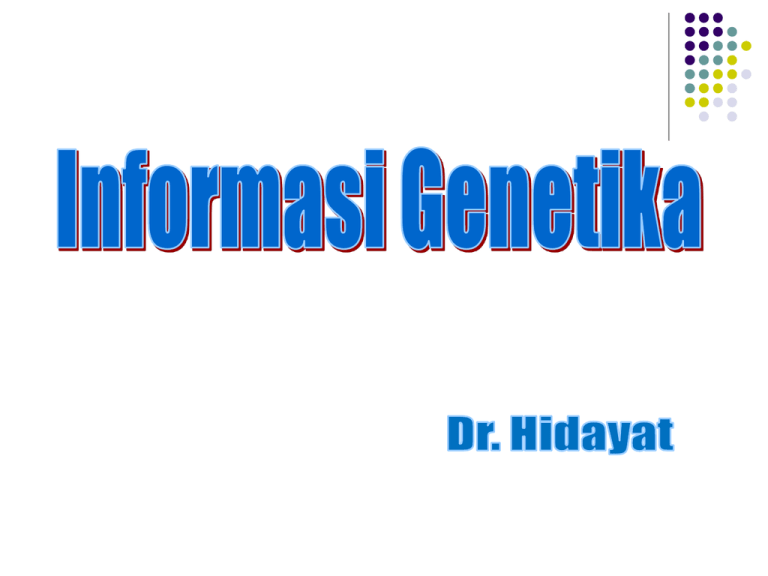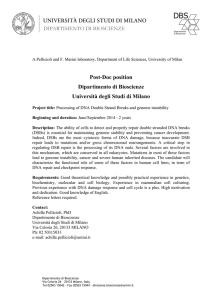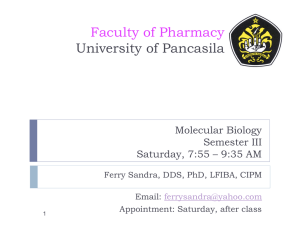
Seorang ibu membawa anak laki-lakinya yang berumur 10
tahun ke Unit Gawat Darurat salah satu RS Swasta. Ia
baru saja membawa anaknya ke dokter gigi dan ketika itu
salah satu gigi anaknya terpaksa harus dicabut. Setelah
dicabut, perdarahan yang terjadi tidak dapat ditanggulangi
oleh dokter gigi, dan kemudian ia dirujuk untuk segera
dibawa ke rumah sakit. Dari keterangan ibunya, anak
tersebut sering mengalami perdarahan sejak usia 5 tahun
terutama setelah terbentur atau terjatuh. Riwayat penyakit
keluarga,saudara laki-laki kandung si ibu mengalami
keluhan perdarahan yang sama dan telah meninggal dunia
saat usia anak-anak. Pada pemeriksaan fisik penderita
tampak lemah dengan kesadaran compos mentis, dan
wajah terlihat pucat. Oleh dokter jaga, pasien ini
didiagnosa sementara dengan Hemofilia.
Pedigree of Hemophilia
in One Family
female
normal male
hemophilic male
Hemophilia
Hemophilia - A sex linked genetic disorder in
which blood clotting is deficient
Hemophilia A - lack of antihemophilic globulin
Most common type (80% of cases).
Hemophilia B - defect in thromboplastic
component - a milder form of the disease.
Sex linked - trait found on X chromosome.
How about cancer ?
Chromosome, DNA, Gen
22.3
22.2
22.1
p
21.2
21.3
21.1
11.4
11.3
11.23
11.22
11.21
11.1
11.1
11.2
12
X Chromosome
growth control factor, X-linked
Xg blood roup
ocular albinism
sensorineural deafness
anemia, sideroblastic, with
Spinocerebellar ataxia
13
21.2
22.2
21.1
cleft palate
21.3
lymphoproliferative syndrome
22.1
22.3
23
24
25
q
26
27
28
Simpson dysmorphia syndrome
coagualation factor IX, hemophilia B
blue-monochr. color blindness
coagulation factor VIIIc,hemophiliaA
homosexuality, male
Chromosomes
BODY PROTEIN
Enzyme
Receptor
Hormone
Growth Factor
Immunoglobulin
Interferon, Interleukin, Cytokine
Adhesions molecules
HLA/MHC
STRUKTUR PROTEIN
SIFAT PROTEIN
FUNGSI PROTEIN
PEMBENTUKAN PROTEIN
DISTRIBUSI PROTEIN
PEMERIKSAAN PROTEIN
Proteins are composed of subunits called amino acids
Chromosomes
Long strands of DNA packaged and
compressed very tightly
Everyone has 2 sets (1 pair) of
chromosomes
1 pair of each of the 22 ‘autosomes’
plus XX for a female (46XX)
or XY for a male (46XY)
1 is inherited from mum, 1 from dad
You pass 1 of each pair onto each child
Biokimia : DNA adalah Polymer dari
Desoxyribonucleotide (Basa, zat Gula dan 1
atau lebih gugus Phosphat)
Zat Gula : -D-2 Desoxyribose (Ribose)
Ikatan N-Glykosida antara Desoxyribose
(C1) dengan Pyrimidin (N1) atau Purin (N9)
Desoxy ribonucleic acid
Sanger dan Gilbert (1975) : methode
sequensi Basa Nukleotida (A, T, C, G)
Nukleotida : 2,9 milyar (990 mm) di
Chromosome (inti sel)
Telah selesai disequensi pada Juli 2000
Gen : Sepotong DNA (Intron atau Exon)
A-T
G-C
Satuan DNA : bp (base pair)
DNA Base Pairing
A G C G A T C T G G
T C G C T A G A C C
Double helix consists of 2
complimentary strands of DNA.
DNA Replication
Each of the 2 DNA strands is copied by
machinery in the cell
Each new ‘daughter’ strand has a sequence
complimentary to the original ‘template’
strand
Replication essential to allow cell division
(Mitosis) where 1 cell becomes 2
DNA Replication
C
C
A
T
DNA
unzips
A
T
T
A
G
T
T
A
A
New strands G
formed
G
A
T
C
semi-conservative
2 daughter cells
Replikasi DNA berlangsung pada kedua
helix dengan arah yang berlawanan
3’
5’
3’
5’
DNA Replication
Replication fork : leading strand and lagging
strand
DNA synthesized in the 5’ – 3’
The 5’-3’ synthesis of the leading strand is
continuous.
The lagging strand is also synthesized in the 5’3’ direction but in small segments
This segments referred to as Okazaki fragments
Okazaki fragments has 100 – 200 nucleotides
DNA ligase joined the Okazaki fragments.
5 DNA Polymerase : α, β, δ, ε and γ
DNA Replication and Chromosomes
During the replication of chromosomes,
there is a cross-over of portions of one DNA
strand to another (of the same
chromosome).
This cross-over, along with randomization
assures that offspring differ from the
parents.
meiosis
+
Genes
Segments of DNA code for proteins (or
parts of proteins)
Each coding segment is called a gene
One gene codes one protein (or part of)
Genes contain the information which
makes us what we are
Gene Structure
Every three bases of DNA is called a ‘codon’
Each codon specifies an amino acid which
join together to form the protein
eg ATG = methionine = START
TAA = STOP
TAG = STOP
TGA = STOP
Gene Structure
Introns
Promoter
Exons
ATG
start
TAA
TAG ‘stop’
TGA
Exon = coding sequence
Intron= intervening sequence
(non-coding)
Protein Synthesis
transcription
DNA
RNA
Protein
translation
Nukleotida 1.
(5’)
U
Nukleotida 2.
Nukleotida 3.
C
A
G
U
Phe
Ser
Tyr
Cys
U
U
Phe
Ser
Tyr
Cys
C
U
Leu
Ser
STOP
STOP
A
U
Leu
Ser
STOP
Trp
G
C
Leu
Pro
His
Arg
U
C
Leu
Pro
His
Arg
C
C
Leu
Pro
Gln
Arg
A
C
Leu
Pro
Gln
Arg
G
(3’)
U
C
A
G
A
Ile
Thr
Asn
Ser
U
A
Ile
Thr
Asn
Ser
C
A
Ile
Thr
Lys
Arg
A
A
Met
Thr
Lys
Arg
G
G
Val
Ala
Asp
Gly
U
G
Val
Ala
Asp
Gly
C
G
Val
Ala
Glu
Gly
A
G
Val
Ala
Glu
Gly
G
Perbedaan Sandi Nukleotida
Nukleotida :
UGA
AUA
AGA
AGG
Chr. :
Mit. :
Stop
Ile
Arg
Arg
Trp
Met
Stop
Stop
Mutations
A change in the DNA sequence of the
gene
All cells acquire mutations as they
divide
-6
rate of approx 10 per gene per cell
Mutations can alter protein product of
DNA, stop gene working or activate
gene
Types of Mutation
Deletion - DNA missing
Insertion - extra DNA inserted
Expansion (Amplification) - DNA
repeat size has increased
Point Mutation - change in one base
Types of Mutation
(in coding sequence)
AGC TTC GAC CCG
AGC TCG ACC CG
AGC TTC CGA CCC G
AGC TTC TTC GAC CCG
ATC TTC GAC CGG
Wild type
Deletion
Insertion
Expansion
Point mutation
POINT MUTATION
UAA
(Termination Codon)
UCA
(Codon for Serine)
UCU
(Codon for Serine)
CCA
(Codon for Proline)
PEMERIKSAAN DNA
DNA di-isolasi dari sel (darah atau jaringan)
DNA menjadi “template” atau “matrix” untuk
proses amplifikasi
Sense : 5’- ATG(Start) -GGT-TCT-GTT-GCTGCT-TGG-TAA(Stop)- 3’
Antisense : 3’ - TAC-CCA-AGA-CAA-CGACGA-ACC-ATT- 5 ‘
Exon dan/atau Intron dapat berfungsi
sebagai Matrix untuk amplifikasi
Polimerase Chain Reaction (PCR)
Tahun 1985, Kary Mullis, California
Metode untuk meng-amplifikasi (melipat
gandakan) fragment DNA (Gen)
Dibutuhkan :
DNA atau RNA
Oligonucleotidprimer (PRIMER)
Enzym Taq-Polimerase
Campuran dari 4 Basa Nukleotida
(d’NTPs)
10 x Reactions Buffer
Larutan MgCl2
Alat : Thermal Cycler
Prinsip : perobahan temperatur secara
otomatis dengan waktu yang telah ditentukan
Dapat diatur (Program)
Contoh : 95 °C------ Denaturasi
55 °C------ Hybridisasi
(Annealing)
72 °C------ Synthese DNA
(Extension)
Lama reaksi, bervariasi tergantung panjang
fragment DNA (2 min. : < 1000 Nukleotida)
RNA
Single strand (Uracil pengganti Thymin)
Transkripsi dari DNA
mRNA
Mengandung informasi genetik dari Exon
Dengan Enzym Reverse Transkriptase
diperoleh DNA dari RNA
cDNA
Reaksi PCR nya disebut RT-PCR
Taq-Polimerase
Klenow - DNA Polymerase dari E.Coli
1988 : Taq-Polymerase dari Bakteri Thermus
aquaticus
Hybridisasi dan Polimerisasi berlangsung pada
temp. 50-70 °C
Perhatikan : Buffer yang digunakan
(10 x RB) dan diperlukan MgCl2
Primer
Sequence dari Nukleotida tertentu (Intron
atau Exon) : 20 – 30 bp
Prinsip : merupakan complementare dari
kedua strand DNA (Forward Primer dan
Reverse Primer).
Dari kedua Primer ini disinthese DNA yang
baru dan seterusnya berfungsi sebagai
matrix untuk siklus berikutnya.
Penentu bagi fragment DNA yang akan
diamplifikasi
PCR-REACTION
PCR-Reaction
PCR Product
(Amplifikat)
Gel-elektrophorese (Agarose)
Southern Blot (Hybridisasi dengan Sonde
DNA spesifik)
Dot - Blot (deteksi : Enhanced Chemie
Luminescense = ECL)
Denaturating Gradient Gel Electrophorese
(DGGE) atau Pulse Field Gel
Electrophorese (PFGE)
Enzym Restriksi : Restriction
Endonuclease
Sequence analysis (DNA Sequencing)
cytoplasmic
proteins
free
ribosomes
RER
Protein
Traffic
Aplikasi teknologi DNA
INFEKSI SALURAN CERNA :
Membedakan jenis : pathogen – non
pathogen (Eschericia coli)
Untuk bakteri yang sulit dikultur oleh karena
memerlukan syarat tertentu (Campylobacter)
Membedakan jenis bakteri dari toxin yang
diproduksinya (E. coli dan Shigela sp.)
Subklas bakteri : Campylobacter,
Helicobacter
Mengidentifikasi jenis Rotavirus (A, B, C)
Aplikasi teknologi DNA
Mycobacterium tuberculosis :
Membedakan jenis atypic, dengan mikroskop
hal ini tidak mungkin
Kultur : waktu yang lama dan bakteri harus
banyak (terutama untuk sensitivity test)
Diagnose cepat dibutuhkan, mis. pada
penderita AIDS.
Ditemui jenis yang multi drug resistant (MDR)
Diagnosa dengan PCR dan Hybridisasi (contoh
: dot-blot)
Carcinogenesis (Colorectal
Cancer)
Penerapan Teknologi Gen/DNA dalam
Therapy
Produk dari gen untuk therapy dan
prophylaxis :
Erythropoietin
Insulin
Hormon pertumbuhan
Faktor pembekuan darah VIII
Plasminogen aktivator
Vaksin Hepatitis B
Aplikasi gen dalam Forensik
Sebelum teknologi DNA diterapkan (1978)
biasanya digunakan protein, misalnya
antigen gol.darah, HLA, dll.
1985 : DNA Polymorphismus.
Nov.1987 : DNA sebagai barang bukti di
pengadilan di Inggris.
Sampai akhir 80-an : lebih dari 1000 perkara
dibantu oleh bukti-bukti DNA
Juga dapat menentukan Paternity
Profil DNA tiap individu berbeda


